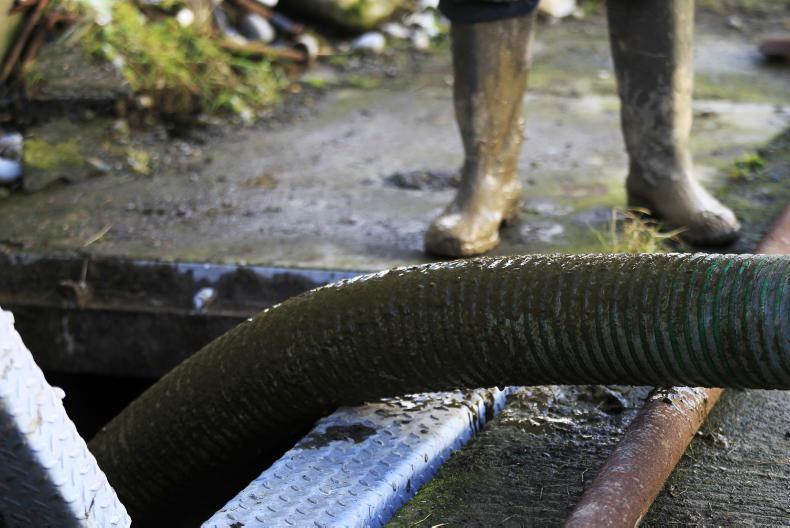The importance of properly managing slurry is well understood at farm level, both from a pollution prevention point of view but also from a nutrient use efficiency perspective.
Investing in slurry storage and capacity is a necessary cost for most farms.
Requirements for length of storage vary from 16 weeks up to 22 weeks, depending on what zone of the country the farm is in.
The Teagasc recommendation is to have a buffer capacity of at least 20% extra capacity to ensure enough storage in the event of adverse weather, etc.
With a value of 6:5:30 for every 1,000 gallons, slurry offers us an excellent source of nutrients, capable of replacing chemical fertiliser.
Storage requirements
The first thing a farmer needs to do is establish how much extra storage is required. Slurry requirements are 0.33m3/cow/week, but there is the expectation that this is going to increase by 25% at the next nitrates action programme. Depending on what zone the farm falls under, they will need to adjust storage in line with this.
Take, for example, a 100-cow herd in Zone B with a storage period requirement of 18 weeks. This farm has a requirement for 594m3 of storage. If we include the 20% buffer, that’s 712m3.

Slurry bags offer a cheaper option to farmers regarding slurry storage, with the added flexibility of being able to move the bag from farm to farm.
Soiled water tanks must be separate and the regulations around this are strict. Anything under 1% dry matter can be classed as soiled water.
Farms must have 0.21m3/cow/week for the four-week period required. For a 100-cow herd, that’s an 84m3 storage requirement for soiled water.
We’re looking at three different investment options in this article. A concrete tank with a fence, a slurry tower and slurry bags.
Concrete tanks
Concrete tanks offer an efficient way to store additional slurry. It’s a basic tank with four walls and perimeter fence.
This method gives the option of slatting the tank in the future and building additional youngstock housing or cubicle housing. You will always have the option of putting a roof over the tank in time.

Concrete slurry tanks will need to be covered or fenced.
Cost per cubic metre or cost/cow is very dependent on the build of the tank, with things such as depth or width of the tank affecting costs differently.
An approximate cost of €130/m3 is outlined by Teagasc based off 2025 figures. If you require storage for an additional 20 cows for 18 weeks, at 0.33m3/week requirement, that’s 5.94m3 per cow, not accounting for a surplus percentage.
For the 20 cows, that’s around 120m3. At a cost of €130/m3, it’s an overall investment of €15,600 in the concrete before VAT.
As the tank is uncovered, a fence would need to be erected around the tank, with a cost of around €1,800 after VAT. It’s a total cost of about €19,500 without taking account of TAMS grants. That’s a cost of €975/cow after VAT, but excluding the TAMS grant.
Overground tower
An overground tower is no doubt a good option if you plan on expanding a herd significantly in the future. They also offer a good option if digging out a concrete tank is difficult.
They can be erected quickly but are only relevant for bigger scale operations.

Slurry towers are cheaper to construct than concrete towers.
The smallest overground tower is about 90,000 gallons or 409m3. If the tank is covered, this is storage for a maximum of 68 cows at 18 weeks storage.
If we took the smallest available tank of 90,000 gallons, it’s an overall investment of €40,800. The cost/cow for a covered tank is in the region of €740/cow.
Slurry bags
On farms where smaller amounts of additional storage are required, slurry bags could be an option. They come in a range of sizes from about 100m3 (22,000 gallons) up to 2,500m3 (550,000 gallons).
The advantage of the bag is no permanent fixtures are needed. They are 1.6m high so don’t cause the same eyesore as a tower.

The bags can be moved, if necessary, when empty and no rainwater gets in to bag affecting the capacity of it. Similarly to the other options TAMS are available on the slurry bags.
For 20 cows at 120m3 the slurry bag is costing €15,000. With VAT at 23% it’s a cost of €18,450 or €920/cow. This is not including the TAMS grant.
Overall, the costs of each option is a considerable investment, one that requires thought and planning.
The slurry tower is cheaper on a per-cow basis, but the smallest towers available are for upwards of 60 cows. In large-scale farms looking at additional storage, this is the cheapest option of the three.
In smaller farms, there isn’t much of a difference in cost between a concrete tank or slurry bags. Slurry bags don’t require planning permission, which is a big benefit.
The bags are a quick option and don’t require digging or rock breaking, but there are restrictions on the type of slurry that can be stored in these bags, with more watery slurry preferred over thick slurry.
The alternative though is that a concrete tank can always be used in further development if additional housing was required, which is a bonus.
Additional slurry storage is getting the full five stars from me. The value of slurry is becoming increasingly important as nitrogen input levels drop.
Having adequate storage not only keeps you in line with regulations, but also improves the utilisation of the available slurry on the farm.
This eases the burden at pinch points of the year and will contribute towards improving water quality by not having to spread out of season or in poor weather.
The importance of properly managing slurry is well understood at farm level, both from a pollution prevention point of view but also from a nutrient use efficiency perspective.
Investing in slurry storage and capacity is a necessary cost for most farms.
Requirements for length of storage vary from 16 weeks up to 22 weeks, depending on what zone of the country the farm is in.
The Teagasc recommendation is to have a buffer capacity of at least 20% extra capacity to ensure enough storage in the event of adverse weather, etc.
With a value of 6:5:30 for every 1,000 gallons, slurry offers us an excellent source of nutrients, capable of replacing chemical fertiliser.
Storage requirements
The first thing a farmer needs to do is establish how much extra storage is required. Slurry requirements are 0.33m3/cow/week, but there is the expectation that this is going to increase by 25% at the next nitrates action programme. Depending on what zone the farm falls under, they will need to adjust storage in line with this.
Take, for example, a 100-cow herd in Zone B with a storage period requirement of 18 weeks. This farm has a requirement for 594m3 of storage. If we include the 20% buffer, that’s 712m3.

Slurry bags offer a cheaper option to farmers regarding slurry storage, with the added flexibility of being able to move the bag from farm to farm.
Soiled water tanks must be separate and the regulations around this are strict. Anything under 1% dry matter can be classed as soiled water.
Farms must have 0.21m3/cow/week for the four-week period required. For a 100-cow herd, that’s an 84m3 storage requirement for soiled water.
We’re looking at three different investment options in this article. A concrete tank with a fence, a slurry tower and slurry bags.
Concrete tanks
Concrete tanks offer an efficient way to store additional slurry. It’s a basic tank with four walls and perimeter fence.
This method gives the option of slatting the tank in the future and building additional youngstock housing or cubicle housing. You will always have the option of putting a roof over the tank in time.

Concrete slurry tanks will need to be covered or fenced.
Cost per cubic metre or cost/cow is very dependent on the build of the tank, with things such as depth or width of the tank affecting costs differently.
An approximate cost of €130/m3 is outlined by Teagasc based off 2025 figures. If you require storage for an additional 20 cows for 18 weeks, at 0.33m3/week requirement, that’s 5.94m3 per cow, not accounting for a surplus percentage.
For the 20 cows, that’s around 120m3. At a cost of €130/m3, it’s an overall investment of €15,600 in the concrete before VAT.
As the tank is uncovered, a fence would need to be erected around the tank, with a cost of around €1,800 after VAT. It’s a total cost of about €19,500 without taking account of TAMS grants. That’s a cost of €975/cow after VAT, but excluding the TAMS grant.
Overground tower
An overground tower is no doubt a good option if you plan on expanding a herd significantly in the future. They also offer a good option if digging out a concrete tank is difficult.
They can be erected quickly but are only relevant for bigger scale operations.

Slurry towers are cheaper to construct than concrete towers.
The smallest overground tower is about 90,000 gallons or 409m3. If the tank is covered, this is storage for a maximum of 68 cows at 18 weeks storage.
If we took the smallest available tank of 90,000 gallons, it’s an overall investment of €40,800. The cost/cow for a covered tank is in the region of €740/cow.
Slurry bags
On farms where smaller amounts of additional storage are required, slurry bags could be an option. They come in a range of sizes from about 100m3 (22,000 gallons) up to 2,500m3 (550,000 gallons).
The advantage of the bag is no permanent fixtures are needed. They are 1.6m high so don’t cause the same eyesore as a tower.

The bags can be moved, if necessary, when empty and no rainwater gets in to bag affecting the capacity of it. Similarly to the other options TAMS are available on the slurry bags.
For 20 cows at 120m3 the slurry bag is costing €15,000. With VAT at 23% it’s a cost of €18,450 or €920/cow. This is not including the TAMS grant.
Overall, the costs of each option is a considerable investment, one that requires thought and planning.
The slurry tower is cheaper on a per-cow basis, but the smallest towers available are for upwards of 60 cows. In large-scale farms looking at additional storage, this is the cheapest option of the three.
In smaller farms, there isn’t much of a difference in cost between a concrete tank or slurry bags. Slurry bags don’t require planning permission, which is a big benefit.
The bags are a quick option and don’t require digging or rock breaking, but there are restrictions on the type of slurry that can be stored in these bags, with more watery slurry preferred over thick slurry.
The alternative though is that a concrete tank can always be used in further development if additional housing was required, which is a bonus.
Additional slurry storage is getting the full five stars from me. The value of slurry is becoming increasingly important as nitrogen input levels drop.
Having adequate storage not only keeps you in line with regulations, but also improves the utilisation of the available slurry on the farm.
This eases the burden at pinch points of the year and will contribute towards improving water quality by not having to spread out of season or in poor weather.










 This is a subscriber-only article
This is a subscriber-only article










SHARING OPTIONS: